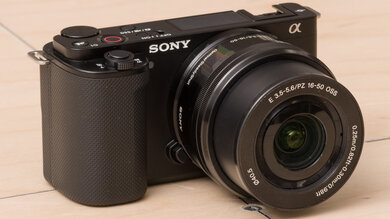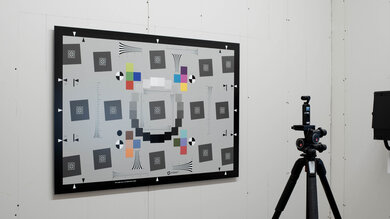
If you're just getting into making YouTube videos, your smartphone camera is probably the best, most cost-effective place to start. Using what you already own also leaves more room in your budget to invest in a good microphone and lighting setup, which is key to creating videos that will stand out in the sea of content on YouTube. That said, there are some things a smartphone can't do. Going with an interchangeable-lens camera gives you more control over the look of your videos. For instance, you can use different lenses to suit different video styles, like creating a shallower depth of field for talking head videos or using a fisheye lens for sports and action videos. Consumer cameras are becoming increasingly powerful video tools, offering more advanced recording formats, higher bit rates, and greater bit depth with Log profiles to give you more editing flexibility. If you want to step up your YouTube game, you'll have no shortage of camera options at different prices.
We've bought and tested over 100 cameras, and below, you'll find the best YouTube cameras we've tested. If you're looking for something even more advanced, you can check out our picks for the best filmmaking cameras or the best 4k cameras more generally. If shooting sports is more your thing, you can also look at the best video cameras for sports.
-
Best YouTube Camera
VloggingStudio VideoAction VideoThe Sony ZV-E1 is Sony's first full-frame vlogging camera and the best 4k camera for YouTube if money is no obstacle. Like other models in the ZV lineup, it has a fully articulated screen that's great for self-recording and a built-in vlogging mic. It doesn't have a viewfinder, but it's one of the most compact full-frame cameras on the market, though full-frame lenses can still add some bulk, so it isn't the most compact option for on-the-go vlogging.
Still, if you tend to shoot in less controlled lighting conditions, this is a fantastic choice, thanks to a full-frame sensor optimized for low-light situations. Features like auto framing or modes like 'Intelligent Auto' and 'Cinematic Vlog' do the heavy lifting to get the right look for your videos. However, the camera also supports internal 10-bit 4:2:2 Log recording, with 4k at up to 120 fps, making it a good fit for advanced shooters who want more flexibility over the production process, from shooting to uploading the final product. All said and done, these features combine to make this one of the best cameras for content creators, period.
-
Best Upper Mid-Range YouTube Camera
VloggingStudio VideoAction VideoIf the Sony ZV-E1 sounds like overkill, you'll be all set with the Sony α6700, which is one of the best 4k cameras for YouTube at its price point. Though it lacks the exceptional low-light capability of the Sony ZV-E1, it's a fantastic and well-rounded APS-C camera. With internal 10-bit 4:2:2 recording, you can capture very high-quality video with more leeway to edit and color-grade your footage. It's also one of the few cameras of its class that can record at up to 120 fps in 4k, albeit with a significant crop.
Beyond that, it features in-body image stabilization (IBIS) for smoother handheld recording, no recording time limits, and the same exceptional AI-driven autofocus found on the ZV-E1. While the α6700 is the best camera for YouTube videos at this price point, don't overlook the Fujifilm X-S20. Unlike the α6700, it can record 6.2k video from the full resolution of its sensor and supports RAW video output to a compatible external recorder. That said, its autofocus isn't as reliable, and this model can't shoot 4k video at 120 fps.
-
Best Mid-Range YouTube Camera
VloggingStudio VideoAction VideoThe Canon EOS R10 is one of the best entry-level cameras we've tested and is a great choice for beginners and more experienced shooters alike. While it doesn't have some of the Sony α6700's more advanced features, like IBIS and Log recording, it does have a fairly wide range of video features, including 4k recording at up to 60 fps (with a crop) and an excellent autofocus system. If you need more dynamic range, the camera does offer 10-bit video capture in its HDR PQ mode, though you won't get as much out of it as 10-bit Log modes on the cameras mentioned above.
Other than that, the camera has great ergonomics, a highly intuitive user interface, a fully articulated touchscreen, and a high frame rate mode for slow-motion recording in 1080p. If you can find one, the Fujifilm X-S10 is another great choice at this price point. It even has IBIS, but its frame rate options are more limited, and it has a less reliable autofocus system.
-
Best Budget YouTube Camera
VloggingStudio VideoAction VideoThe Sony ZV-E10 is one of the best cameras for YouTube beginners on a budget. It's similar to the Sony ZV-E1 above but with less advanced internal recording specs and an APS-C sensor. Like its higher-end stablemate, it lacks a viewfinder, so it isn't as versatile for photography as a hybrid camera like the Canon EOS R10, but it's an excellent vlogging camera for the price. It even has neat extra features, including a specialized 'Product Showcase' mode that automatically switches focus to any object held up in the frame, making it a great choice for product and beauty vloggers.
If you're looking for better stabilization, the similarly priced and more compact Olympus OM-D E-M10 Mark IV comes with five-axis IBIS, making it a great alternative if stabilization and portability are priorities. However, it has a much less reliable autofocus system and uses a smaller Four Thirds sensor. Ultimately, the ZV-E10 is still the best camera for YouTube beginners on a budget, thanks to its larger sensor, class-leading autofocus, and microphone input.
-
Best Cheap YouTube Camera
VloggingStudio VideoAction VideoThe DJI Pocket 2 is unique on this list. This tiny camera has a built-in three-axis stabilized gimbal that ensures your footage looks smooth. While its video quality and low-light capability can't compete with some of the larger-sensor options above, the Pocket 2 can be a powerful all-in-one tool in any content creator's belt, especially if you're on a tight budget. The gimbal makes it incredibly easy to record super smooth handheld footage, and it has a slow-motion capture mode that lets you shoot at up to 240 fps in 1080p.
The camera also has an 'Active Track' feature that automatically follows a person or object, which you can use to get creative when shooting products or action footage. While the newer DJI Pocket 3 offers significant improvements, including a larger 1-inch sensor and bigger screen, it's also significantly pricier. If you don't have that kind of budget, the Pocket 2 is a great deal for content creators who want to shoot stabilized handheld video without spending a fortune on gimbals or extra accessories.
-
Best Point-And-Shoot YouTube Camera
VloggingStudio VideoAction VideoA point-and-shoot camera like the Sony ZV-1 offers portability and convenience if you want something small and simple. It's similar to the other ZV series cameras recommended above. It has a fully articulated screen, special focus modes, and a vlogging microphone, complete with a detachable windscreen to reduce ambient noise. However, its compact fixed-lens design makes it much more portable, so it's a good fit for on-the-go vlogging. While you don't get as much flexibility with a fixed lens, it's an easier jump from your smartphone since you don't have to worry about switching out different lenses.
If you prefer a wider-angle lens, the new Sony ZV-1 II has a wider field of view that, on its face, is a little better suited to vlogging. Just be aware that it's pricier and lacks optical stabilization, with an e-stabilization feature that crops in your field of view anyway. The biggest drawback of a compact camera is a shorter battery life and a tendency to overheat during long recording sessions, but if that isn't a dealbreaker, the ZV-1 is one of the best compact cameras for YouTubers.
Notable Mentions
- Canon EOS R50: The Canon EOS R50 is a great budget vlogging camera. It's even more affordable than the Sony ZV-E10, but it lacks some of the ZV-E10's dedicated vlogging features, like a vlogging mic and specialized focus modes. See our review
- Nikon Z 30: The Nikon Z 30 is a solid budget vlogging camera. Unlike the Sony ZV-E10, it records 4k 30 fps video without a crop, but it struggles with overheating and doesn't have as many lens options as the Sony. See our review
- OM SYSTEM OM-5: The OM SYSTEM OM-5 is a Micro Four Thirds mirrorless camera. Its small size, relatively sturdy build, and five-axis image stabilization make it an excellent choice for outdoor and on-the-go vlogging. However, its internal recording capability and autofocus aren't as good as those of the Canon EOS R10. See our review
Recent Updates
-
May 15, 2024: We replaced the Fujifilm X-S10 with the Canon EOS R10 as the mid-range pick, because it has better availability and a better autofocus system. We also removed the Insta360 GO 2 from the Notable Mentions since we're not currently testing action cameras.
-
Mar 26, 2024: We've adjusted the product photos used in the article to be more relevant.
-
Feb 28, 2024: We've removed the GoPro HERO10 Black as a result of pausing our action camera testing; it's been replaced by the DJI Pocket 2 as the 'Best Cheap YouTube Camera.'
-
Feb 06, 2024: Added mention of the DJI Pocket 3 to ensure the article is up to date with current market conditions.
-
Jan 08, 2024: Replaced the Olympus OM-D E-M5 Mark III with the OM SYSTEM OM-5 as a Notable Mention.
All Reviews
Our recommendations above are what we think are currently the best video cameras for YouTube for most people to buy, according to their needs. We factor in the price, feedback from our visitors, and availability (no cameras that are difficult to find or almost out of stock in the U.S.).
If you would like to choose for yourself, here's the list of all our reviews for cameras. Be careful not to get caught up in the details. There is no single perfect camera. Personal taste, preference, and shooting habits will matter more in your selection.





























